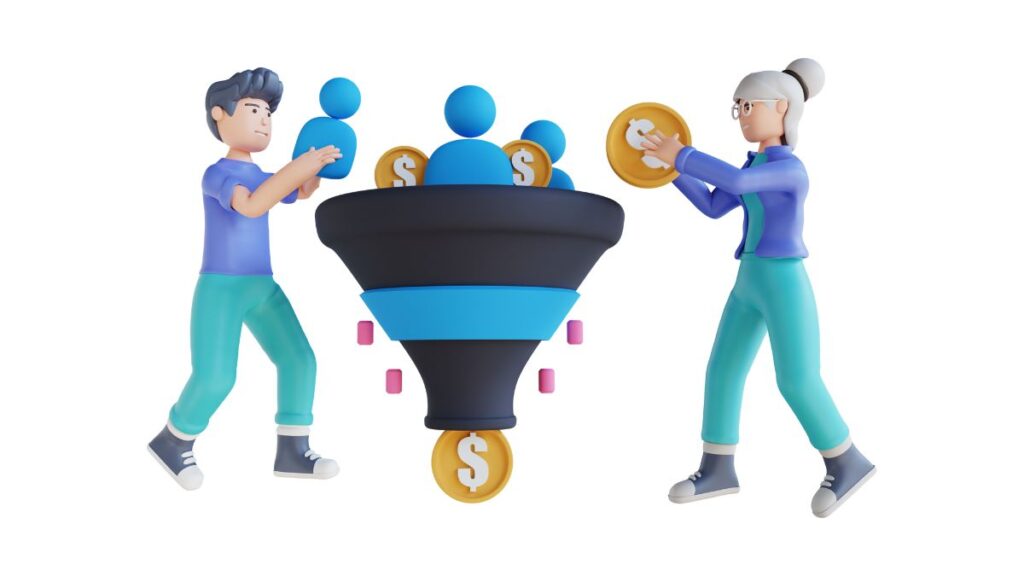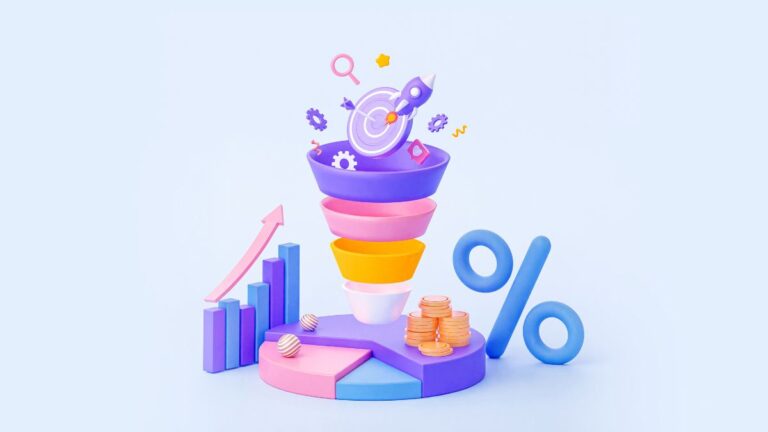Marketing funnels are the backbone of any successful digital marketing strategy. A well-designed funnel can help you attract potential customers, nurture relationships with them, and ultimately turn them into loyal brand advocates. But what exactly is a marketing funnel? How does it work? And most importantly, how can you create one that truly drives results for your business? In this article, we’ll answer these questions and more as we dive into the 10 things you need to know about marketing funnels. Whether you’re a seasoned marketer or just getting started in the world of digital advertising, this guide will provide invaluable insights to help you optimize your funnel and grow your business.
What is a Marketing Funnel?
A marketing funnel is a series of steps that a potential customer goes through before making a purchase. It’s called a “funnel” because, just like the kitchen tool, it narrows down from a wider opening at the top to a smaller one at the bottom. The goal of the funnel is to guide leads towards conversion by providing them with valuable information and building trust.
There are typically four stages in a marketing funnel: awareness, interest, decision, and action. During the awareness stage, customers become aware of your brand or product through various channels such as social media or advertising. In the interest stage, they start actively seeking out more information about what you offer. The decision stage is where they decide whether or not to make a purchase and finally take action by buying your product or service.
Creating an effective marketing funnel involves understanding your target audience and tailoring each step of the funnel to their needs. By guiding them along this journey with relevant content and messaging, you can build lasting relationships with customers and increase conversions for your business.
Understanding the stages of a marketing funnel
The marketing funnel consists of three stages, each with its own purpose and unique characteristics.

A. Top of the funnel (TOFU)
TOFU is the initial stage of the funnel, where potential customers are first introduced to your product or service. At this stage, the focus is on building brand awareness and attracting as many potential customers as possible.
The key goal of TOFU is to create interest and generate leads by providing valuable content and information that addresses potential customers’ needs and pain points. Content types such as blog posts, social media posts, and infographics are commonly used in this stage.
B. Middle of the funnel (MOFU)
MOFU is the consideration stage, where potential customers are evaluating their options and deciding whether your product or service is the right fit for them. At this stage, the focus is on educating potential customers about the value of your product or service and how it solves their problems.
The key goal of MOFU is to nurture leads and build a relationship with potential customers by providing valuable content such as case studies, white papers, and webinars. This stage is critical for establishing trust and credibility with potential customers.
C. Bottom of the funnel (BOFU)
BOFU is the decision stage, where potential customers are ready to make a purchase. At this stage, the focus is on converting leads into customers by providing a clear call-to-action and making the purchasing process as easy as possible.
The key goal of BOFU is to provide potential customers with the information they need to make an informed decision and remove any barriers to conversion. Content types such as product demos, free trials, and testimonials are commonly used in this stage.
By understanding the unique characteristics and goals of each stage, businesses can tailor their messaging and content to address potential customers’ needs and pain points at every stage of the funnel, improving the likelihood of conversion.
How to Create a Marketing Funnel?
Creating a marketing funnel is essential for any business looking to grow and convert leads into customers. To create an effective marketing funnel, it’s important to start by defining your target audience and the stages they go through before making a purchase.
The first step in creating a marketing funnel is to build awareness around your brand. This can be achieved through various channels such as social media, content marketing, or paid advertising.
Once you have captured the attention of potential customers, the next stage is to generate interest in your product or service. This can be done by offering valuable information that positions you as an expert in your industry.
From there, move on to helping prospects evaluate their options and make informed decisions about whether or not your product or service is right for them. This involves providing detailed information about your offerings and highlighting their unique benefits.
Once prospects are ready to make a purchase decision, it’s crucial that you provide clear calls-to-action that guide them towards completing the transaction seamlessly.
By following these steps and customizing each stage of the funnel based on your specific business needs, you’ll be able to create an effective marketing strategy that increases conversions and drives growth for years to come.
Try Exly’s Marketing Tools For Free
Why Use a Marketing Funnel?

Marketing funnels are essential for businesses that want to convert potential customers into loyal ones. They help you understand the different stages of a customer’s journey, from awareness to consideration and decision-making. By using a marketing funnel, you can develop strategies that cater to each stage of this journey.
One reason why you should use a marketing funnel is that it helps create a streamlined and efficient sales process. This is by narrowing down your target audience according to their interests and needs. This way, your efforts will be more focused on those who are most likely to become paying customers.
Moreover, having a well-defined marketing funnel also allows you to track the progress of your leads. This is as they move through each stage. You can identify where people drop off in the process or where improvements need to be made.
Another benefit of using marketing funnels is that it enables better communication with potential customers by providing them with relevant content at every step of their journey. This helps establish trust and credibility with your brand while building long-term relationships.
The Benefits of a Marketing Funnel
The benefits of a marketing funnel are numerous and can greatly impact the success of your business. One major benefit is the ability to track customer behavior throughout the buying process. By understanding where customers drop off, businesses can adjust their strategies and improve conversion rates.
Another benefit is personalization. Marketing funnels allow for targeted messaging based on where a customer is in the buying process. This creates a more personalized experience for them. This leads to higher engagement and ultimately, more sales.
Marketing funnels also help with lead generation by capturing contact information early in the process and nurturing those leads until they are ready to make a purchase. This allows businesses to build relationships with their audience and increase brand loyalty over time.
By implementing a marketing funnel, businesses can also save time and resources. This is by automating certain tasks such as email campaigns or social media posts. This frees up valuable time for employees to focus on other important aspects of the business.
Marketing funnels provide a clear path from initial interest to final purchase while providing valuable data insights along the way. Implementing one can greatly improve overall business performance and drive growth in both sales and customer loyalty.
10 Tips for Optimizing Your Marketing Funnel

Optimizing your marketing funnel is essential in getting the best results. Here are 10 tips for optimizing your marketing funnel:
1. Understand Your Audience: The first step towards optimizing your marketing funnel is understanding who your audience is, their needs, and preferences.
2. Define Your Goals: Clearly define what you want to achieve with your marketing funnel before launching it.
3. Create Engaging Content: Attract potential customers by creating engaging content that addresses their pain points.
4. Offer a Lead Magnet: To get people into the top of the funnel, offer them something valuable like an eBook or webinar in exchange for their contact information.
5. Use Clear CTAs: Have clear calls-to-action (CTAs) throughout each stage of the funnel. This will move prospects down through the stages faster.
6. Personalize Email Campaigns: Tailor email campaigns based on where leads are in the funnel. And what actions they have taken so far.
Also Read: The Ultimate Guide to Creating a Newsletter That Engages and Converts
7. Use Retargeting Ads: Keep leads engaged with retargeting ads on social media or search engines. This will bring them back into your sales process if they drop off mid-funnel.
8. Test and Optimize Continuously: Continuously test different components of your marketing funnels such as headlines, images, copy and CTAs to see which ones improve conversions rates.
9 . Analyze Metrics Carefully : Monitor metrics such as conversion rate , bounce rate , time spent per page etc.. This will help identify areas that may need improvement.
10 . Nurture Leads With Follow-Up Emails : Once someone has made a purchase don’t just stop there continue nurturing them with follow-up emails. Also, provide relevant information about other products/services that could be useful.
By implementing these optimization tips in combination with an effective marketing strategy tailored specifically around a well-structured Marketing Funnel will maximize its effectiveness enabling businesses to achieve their goals efficiently
Conclusion
Marketing funnels are an essential part of any successful marketing strategy. By understanding the different stages of a funnel and how to optimize them, businesses can attract, engage, and convert their target audience into loyal customers.
Remember that creating a marketing funnel is not a one-time job; it requires constant tweaks and optimizations to stay effective. Always analyze your data and test new tactics to improve your funnel’s performance continually.
Whether you’re just starting or have an existing funnel in place, use these ten tips to create an optimized marketing funnel that drives results for your business.
By implementing these strategies effectively, you’ll be able to generate more leads, nurture relationships with potential customers, increase sales revenue and ultimately grow your business. So start building your marketing funnel today!





